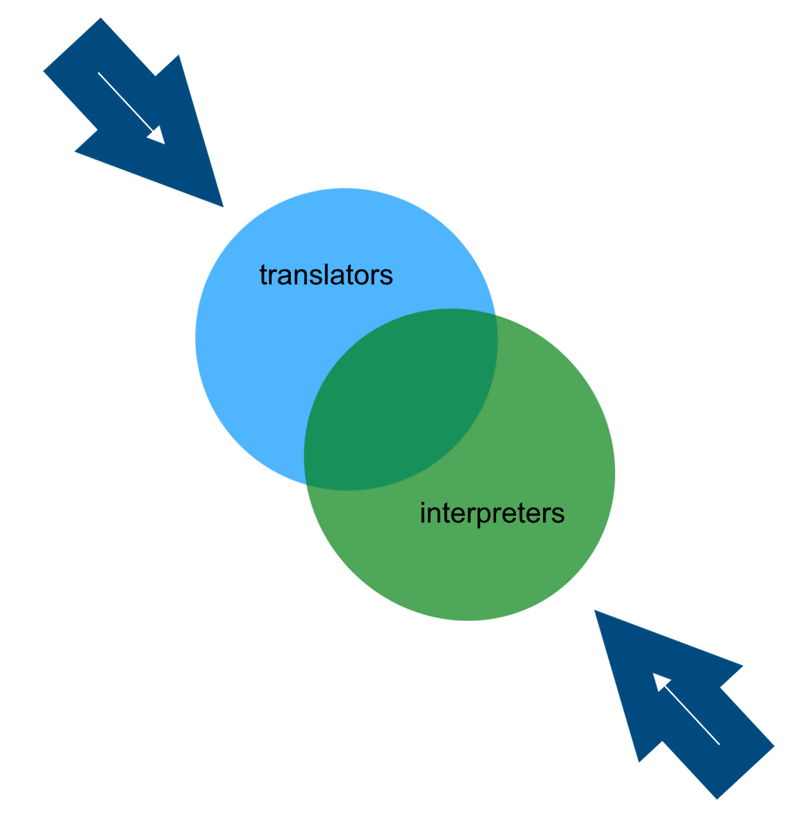If you read last year’s ProZ.com industry report for freelancers-- or maybe you heard the audio version narrated by Paul Urwin on the ProZ.com podcast-- you may remember that we looked at two main trends that were affecting interpreters...
The transinterpretification of things
The first one we’ll talk about is something that has been building for some time now: an increasing overlap between translators and interpreters. Claudia Brauer coined the term transinterpreter to refer to these professionals who do both interpreting and translation. A long-held argument for “sticking to one’s lane” has been that translation and interpreting require different skill sets. That’s probably true, but they are not necessarily mutually exclusive, so plenty of translators and interpreters are discovering that adding the other service to their offering is both good business and fun. At the moment, between 30 and 40% of language professionals offer both services, to some degree or another.
At least as far as interpreters are concerned, this trend was accelerated by the pandemic, when suddenly traditional forms of interpreting disappeared for a while. Many interpreters found themselves office-bound where they had not been before, and picking up a translation project here and there began to make more sense and allowed them to either steady or increase their income. However, there are still more translators moving into interpreting than there are interpreters moving into translation. One possible reason for this is that for those whose main service is translation, it is a bit easier to schedule and juggle translation projects and then jump online for some interpreting gigs in between, whereas for the person whose main service is interpreting, maintaining work volume can sometimes depend on being "on" and available, and you may have little or no warning at all when your next call will come along, making it a bit more difficult to work around deadlines for translation projects.
The transinterpretification of things is happening not just in terms of who is offering what services. Tools which may traditionally have been considered “translator tools” are also being leveraged by interpreters to do better work. Those not in the know might wonder what an interpreter is doing with a CAT tool, for example. We’ll look at this when we get to the “AI and other tech” section of this report.

Remote takes control
The other trend, which was also greatly accelerated by the pandemic, is the growing use of remote interpreting. Pre-pandemic, much of the technology required to loop in an interpreter remotely was already pretty good, and improving. When much of the world was on lockdown, this technology made it possible for many interpreters to continue to reach their clients, and it was pushed to improve and scale more rapidly than it would have on its own. If you were doing in-person interpreting up until then, you probably saw yourself forced to either work remotely or virtually as some called it, or not work at all. Some kinds of interpreting suffered a moment of pause as adjustments were made-- think of all the in-person conferences which were cancelled or postponed until those events found their new online incarnations, for example. Medical interpreting on the other hand, could not afford to pause and probably increased.
Now, in 2023, some of the remoteness has been walked back, at least for the time being. We’re seeing this in all industries to some extent or other, as people struggle to go back to the way things were before, while at the same time struggling to strike the right balance between that and incorporating some of the advantageous tech, procedures, and lifestyle that came out of lockdown.
Business as newsual
But don’t let that fool you-- it won’t be back to “business as usual” ever again. Remote interpreting will continue to grow as both hardware and software improve to support it, and it has some clear advantages if we are thinking about the future:
- It’s safer. In some situations, for example in conflict zones, or some crisis or
health related scenarios, adding an in-person interpreter to the mix can be an
additional security or health risk. - It’s faster. Precious time can be saved by bringing in a remote interpreter, rather
than waiting for an interpreter to arrive on site (if one happens to be near enough
to make it feasible). This can be especially important in emergency situations,
but is also just convenient for the client. - It has greater reach. This reach works from two ends. For the person with the
need, if you need an interpreter, it is increasingly easier to get one right away,
whereas in years past you may have just had to do without, sometimes in
situations where access to language was crucial, life-or-death, even. For the
professional providing the service to meet the need, you are less and less bound
by your location, and doors are now open to many new clients which may not
have been reachable otherwise. If for example you provide interpreting services
in African languages, from Africa, you can now reach clients in the US or Europe
or anywhere else, with relative ease. - And it is more cost-effective. For the client, the decision of “Do I hire an
interpreter for this?” can be made easier if some of the overhead costs normally
associated with interpreting in person can be removed from the equation. In
situations where not having an interpreter physically present does not jeopardize
the quality of the outcome, it just makes good sense to bring them in remotely if
you can.
The way forward is not without its challenges if you are a remote interpreter now or thinking of becoming one. In the next post, we will take a look at the current landscape for remote interpreters...

This post comes from ProZ.com industry overview: (remote) interpreters in 2023. ProZ.com industry reports can be found at https://www.proz.com/industry-report/ . ProZ.com paying members receive immediate, full access to the information available in industry reports, which are about and for freelance language professionals.



